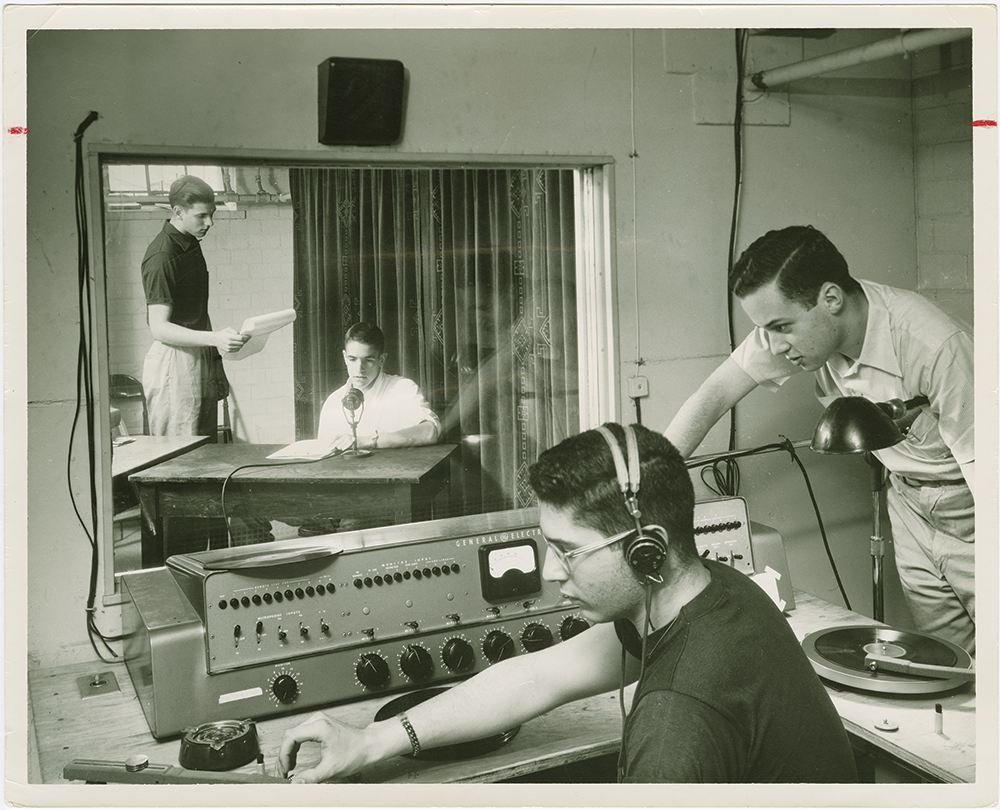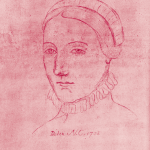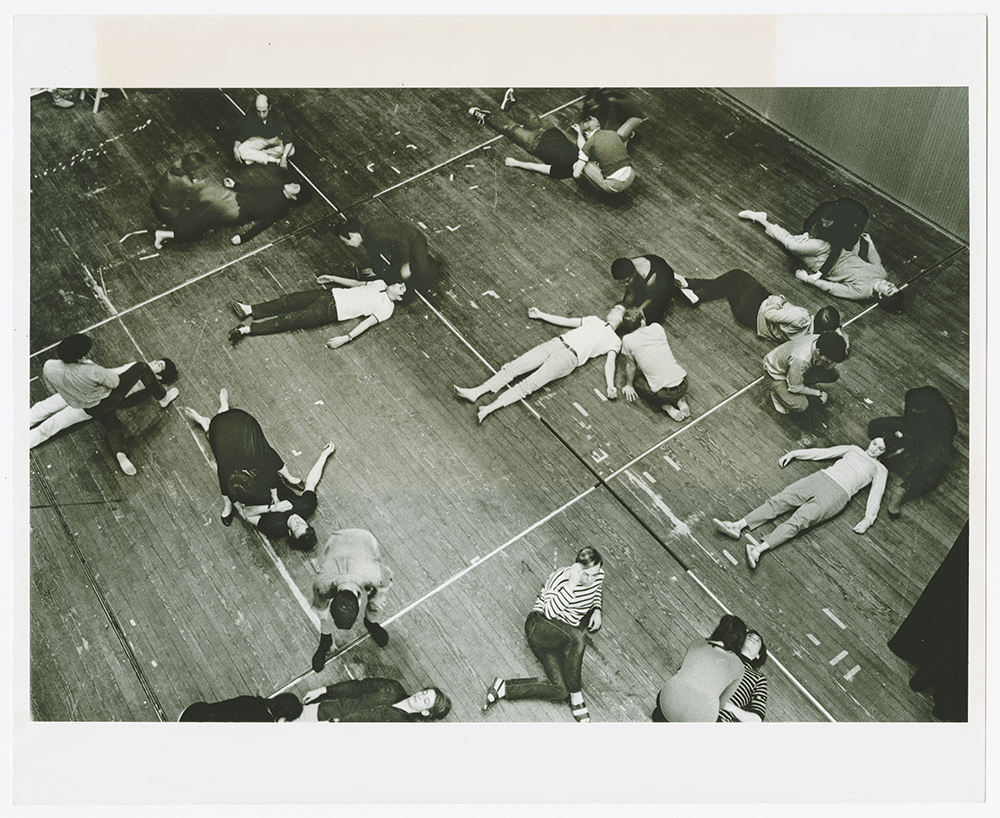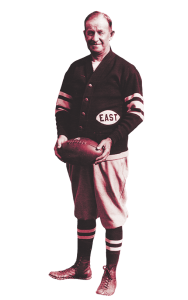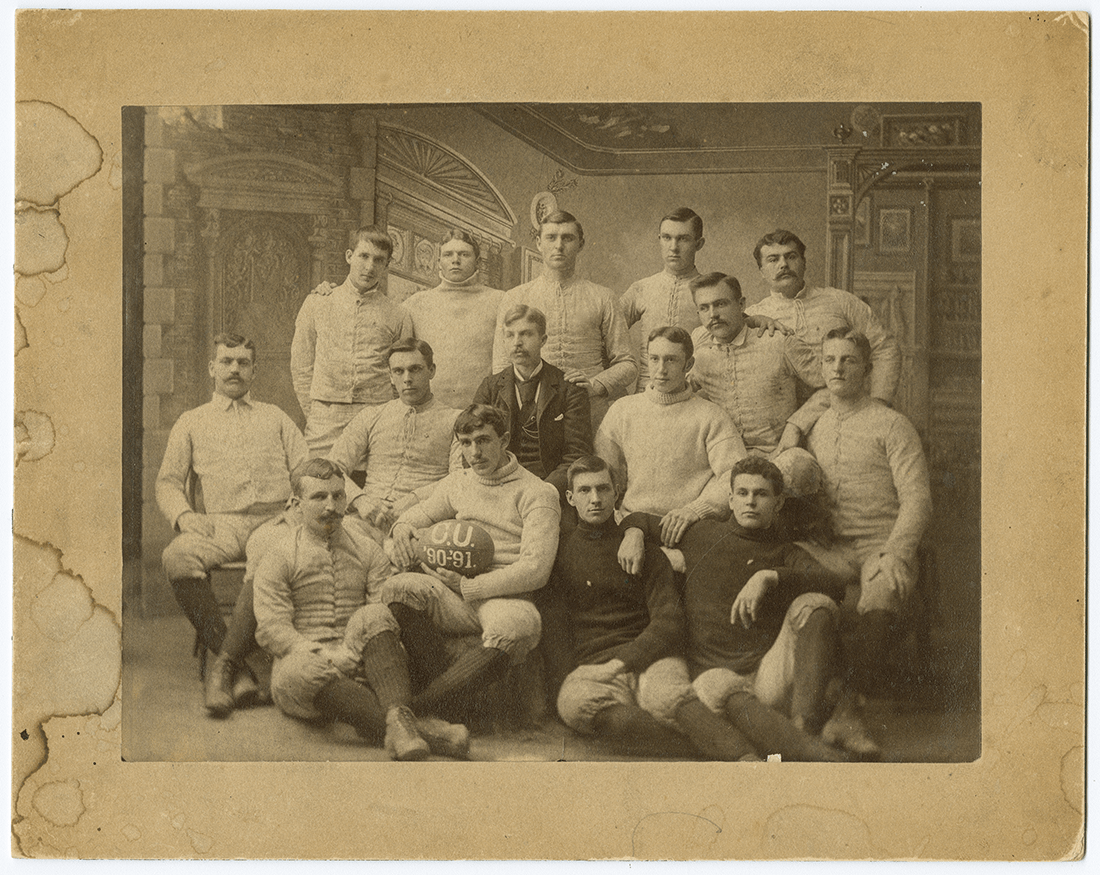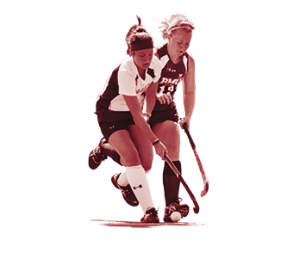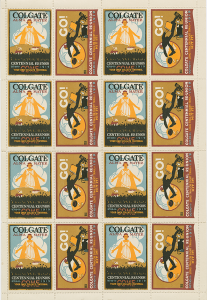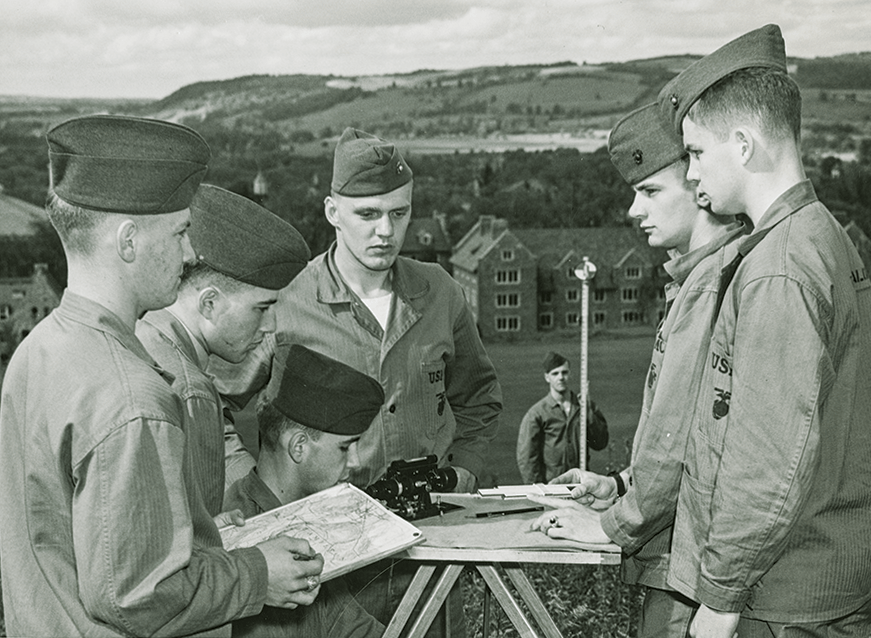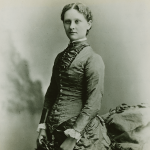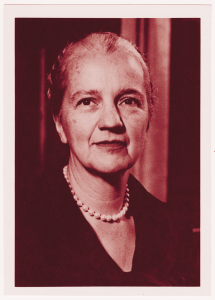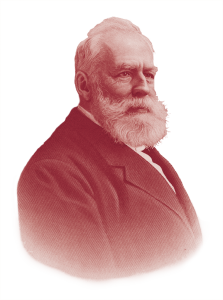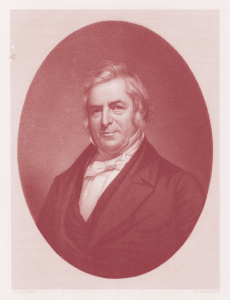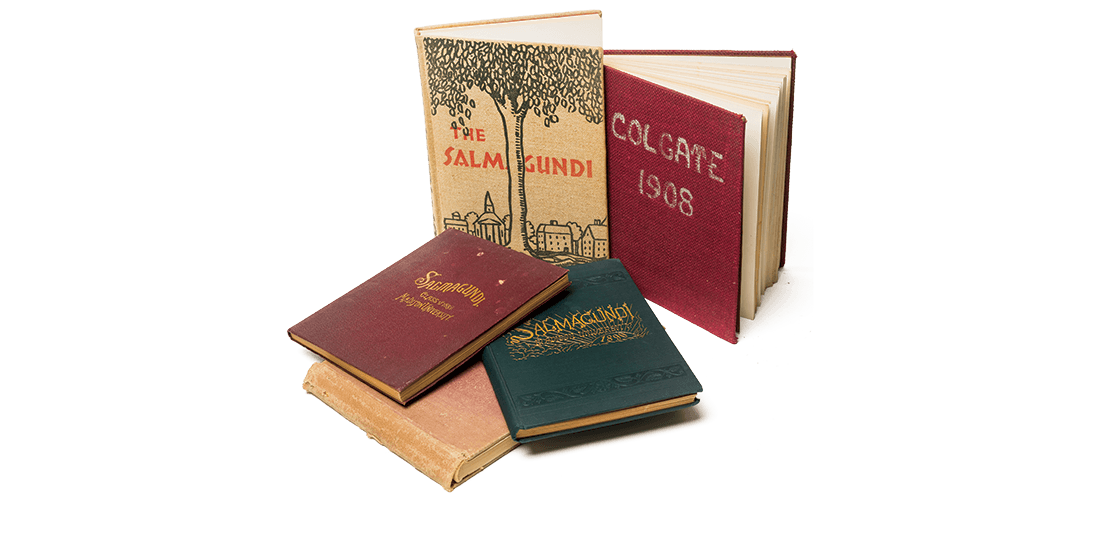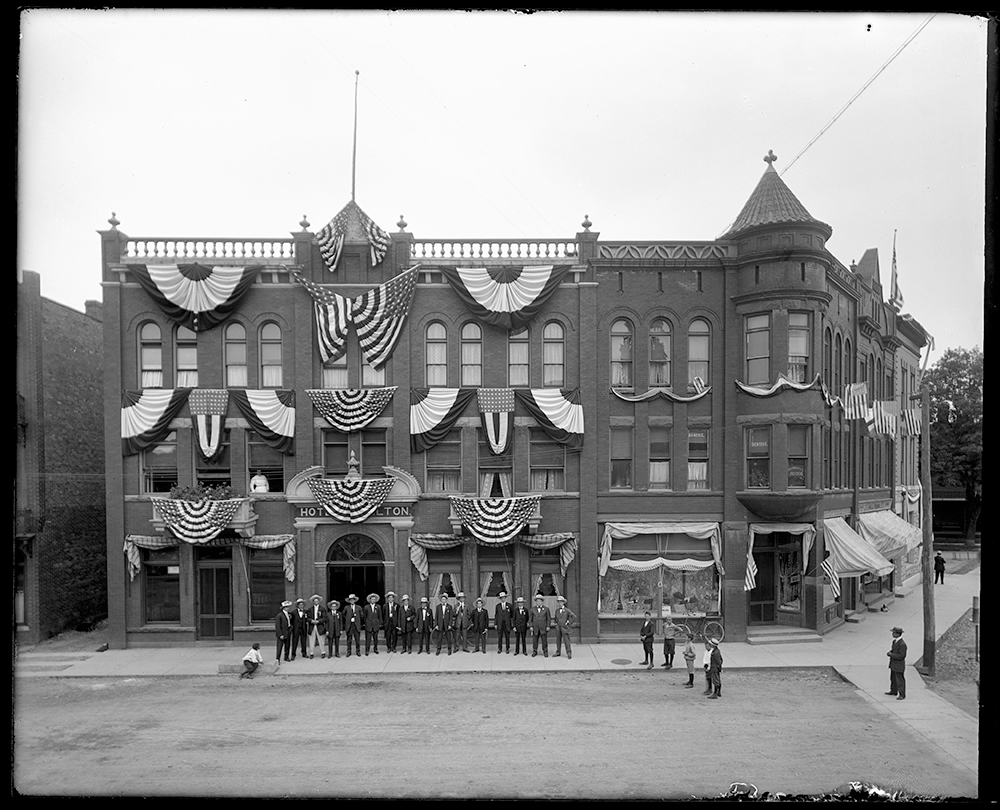A somewhat complete list of historical facts, titillating truths, blatant brags, astounding oddities, and more.
Student Life
Not missed: “Exercise by manual labor”
1
Founded in 1821, the Philomathesian Society was the school’s first student group. The literary society was intended to prepare students for the ministry.
2
Daily schedule of a student in the 1830s:
AM
5–5:30 Chapel
5:30–6 Private devotions
6–6:30 Reading and studying
6:30–7 Breakfast
7–8 Exercise by manual labor
8–8:30 Private devotions
8:30–12 Studies and recitations
PM
12–12:30 Dinner
12:30–1:30 Exercise by manual labor
1:30–5 Studies and recitations
5–5:30 Chapel
5:30–6 Supper
6–6:30 Private devotions
6:30–9 Meetings, reading, and writing
9–9:30 Devotions in room
9:30–4:30 Sleep
3
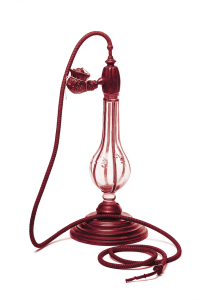 Special Collections object: Hookah owned by Henry M. Campbell, Class of 1842. He was a missionary for the American Baptist Missionary Union in Aracan, Burma.
Special Collections object: Hookah owned by Henry M. Campbell, Class of 1842. He was a missionary for the American Baptist Missionary Union in Aracan, Burma.
4
In the early days of the university, first-year students read Livy’s Ab Urbe Condita Libri as part of the Latin curriculum. To celebrate the end of the year, they held a comedic funeral procession and service followed by the burning of their Livy volumes.
5
For students in the 1850s, taking a bath at the end of a long day wasn’t a relaxing affair. They washed in facilities supplied with spring water, so in wintertime, things got pretty frigid.
6
From 1867 to 1890, students celebrated George Washington’s birthday with a coed literary fête, complete with social activities.
7
During Pipe Day, inaugurated by the Class of 1887, graduating seniors smoked pipes on the Quad in resistance to faculty and administrators who prohibited the habit.
8
In the early 1900s, interclass rivalry was rampant and could get out of hand. For example, in 1915, some students chopped the “flowing locks” of a villager (they later made a court appearance), and in 1921, a group of students burned the Whitnall Field grandstand. But, at year’s end, they always agreed to bury the hatchet — literally, by tossing an ax into Taylor Lake.
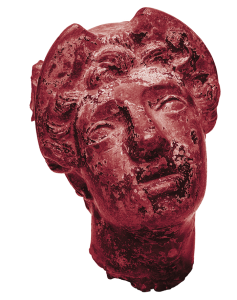
9
Another interclass rivalry tradition involved stealing the bust of Mercury from other classes, who hid it around the Chenango Valley. There were rules: It had to be stashed between Earlville and Bouckville, and it had to appear at every class banquet of the possessing class. The game became dangerous, with tales of students bribing taxi drivers to transport the statue and a student spending a frigid night in a barn to keep Mercury safe.
10
The Colgate-Syracuse rivalry lasted from 1891 until 1961. Legend has it that in approximately 1907, a Colgate student buried his embroidered “C” sweater under the drying cement of Archbold Stadium, forever cursing the team. Later, in 1958, Syracuse University students dyed Taylor Lake Orange; Colgate students dropped red paint on Archbold Stadium.
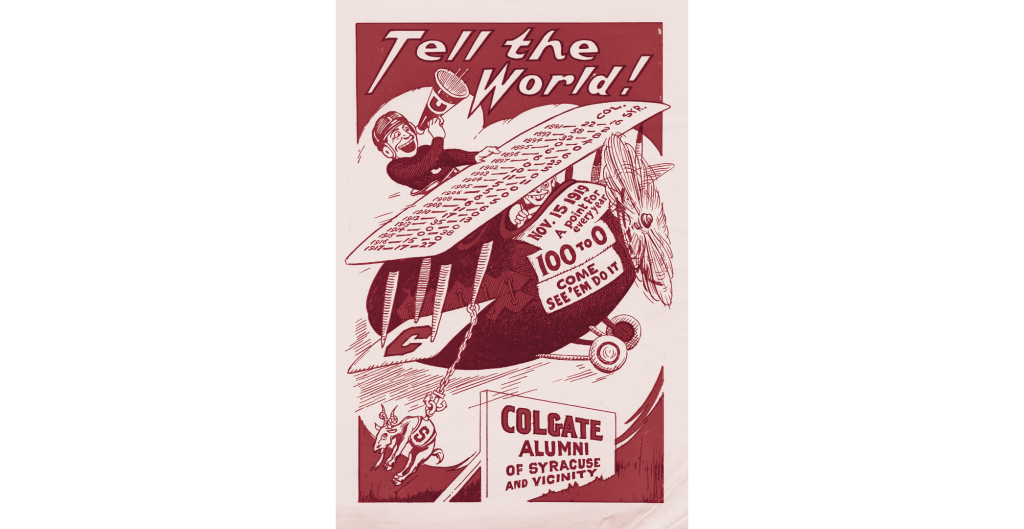
11
Colgate’s first fraternity, Delta Kappa Epsilon, received its charter in 1856, followed by Delta Upsilon in 1866. In 1979, the school’s first local sorority, Delta Nu, was established, and two years later, Gamma Phi Beta granted its national charter.
12
Phi Delta Theta celebrated its 100-year history at Colgate last May. Its intention: to be installed on campuses with a “high and well-established reputation.”
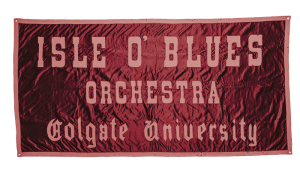
13
The Isle O’Blues Orchestra, a dance orchestra created by six students, began around 1923 and toured the U.S. and Europe.
14
Oct. 20, 1923: First homecoming day
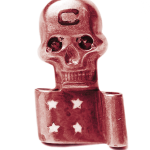
15
In 1934, the Skull and Scroll and the Gorgon’s Head secret societies joined to create the Konosioni senior honor society. Konosioni means “people of the long house,” which honors Iroquois (Haudenosaunee) living traditions.
16
The Colgate Thirteen formed in 1942. They now boast 27 recorded studio albums.
17
When the Colgate Thirteen travels, the dozen plus one singers travel in “The Grunt,” a custom-designed Ford F-550.
18
WRCU FM 90.1 is the largest student-run organization on campus. The station first began broadcasting in 1954 when seniors Bill Heurmann, Phil Hubert, and Marvin Clinch posted a sign that read: “New radio station. Needs technical help. Soldering a plus.”
19
In March 1957, two students stole Colgate’s 80-million-year-old dinosaur egg from Lathrop Hall. They left the egg on the doorstep of a Catholic priest’s house. It now resides in the Linsley Geology Museum.
20
Up until the 1960s, upperclassmen enforced the rules requiring first-year students to don green caps, regularly attend chapel, and recite the alma mater when prompted.
21
1967: Office of Undergraduate Studies is established as the University Scholars Program, providing support to students who have faced significant challenges.
22
Student clubs and organizations include off-the-beaten-path options like the Roleplaying Game Society and the Bellydancing Club.
23
To help students cool off after tours, the admissions office turned to ice cream. The Chipwich tradition started in the early 2000s when Vice President and Dean of Admission and Financial Aid Gary Ross ’77 picked up the cookie sandwiches from Byrne Dairy.
24
The Max A. Shacknai COVE offers alternative breaks during which students can travel to domestic or international locations to engage in community service. Past locations: Neyba, Dominican Republic; New Orleans, Louisiana; and Mexico City, Mexico.
25
The Residential Commons creates community through activities such as Nerd Night, where students gather to learn. In the inaugural event, President Brian W. Casey spoke about what activates his inner nerd: campus architecture.
26
Colgate currently has 56 majors, the newest being film and media studies. Types of classes students can look forward to: Global Cinema, Narrative Screenwriting, and American Popular Culture.
The Written Word
New writing with old origins
27
Colgate’s Special Collections holds the first four Shakespeare folios. One of the folios has the only surviving portrait of Anne Hathaway, the Bard’s wife.
28
Befitting Colgate’s origin as a Baptist college, Special Collections houses a large number of Bibles.

29
Abolitionist George Gavin Ritchie founded the university’s first student newspaper, the Hamilton Student, in 1846.
30
The Maroon-News — which changed names five times over the years — is the oldest college weekly newspaper in the U.S.
31
Colgate’s alumni publication, now Colgate Magazine, was founded in 1904.
32
The junior class published the Junior Daily newspaper for one week every May between 1906 and 1916. The paper covered “Junior Week” (the predecessor to Spring Party Weekend) activities and included the names of party attendees, amusing poetry, play announcements, and cartoons. A single issue initially cost 6 cents.
33
If you needed a laugh between 1920 and 1956, you could flip open the Banter, Colgate’s humor publication. The student-created magazine, complete with colorful cover art, featured stories based on campus events like football games, Winter Carnival, and commencement.
34
The Medieval and Renaissance Drama in England is an international academic journal published annually at Colgate. Since its founding in 1984, it has included more than 500 articles, review essays, and book reviews. Susan Cerasano, Edgar W.B. Fairchild Professor of literature, is one of three editors for the journal; its 12-person editorial board represents a variety of universities.
35
The campus safety blotter, a popular weekly item in the Maroon-News, began in 1995.
36
The Monthly Rag, Colgate’s satirical magazine, was founded in 2007. In the beginning, students printed copies in the Cooley Science Library and hand stapled them; in 2009, funding from Student Government improved production values.
The University Today
Spoiler alert: Dancefest is still a hit
37
In 1910, the university owned approximately 200 acres of land; today, the university owns 575 acres, a 187.5% increase.
38
Colgate has four galleries and museums: The Clifford Gallery for art and art history, the Longyear Museum of Anthropology, the Linsley Geology Museum, and the Picker Art Gallery. The tradition of celebrating exhibitions began when the Longyear Museum opened as a teaching gallery in the 1950s.
39
The flags hanging in Frank Dining Hall represent the makeup of Colgate’s international student body.
40
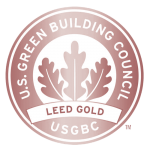
Trudy Fitness Center was the first LEED gold-certified building in Madison County.
41
The university pledges to go carbon neutral by 2019.
42
Case Library is home to a LASR (Library Automated Storage Retrieval) system. It holds VHS tapes, DVDs, vinyl records, less-used books, microfilms, and more.
43
Case-Geyer has approximately 832,561 print book/periodical volumes; 668,260 e-books; and 131,606 print and digital periodicals.
44
Colgate has more than 34,000 living alumni.
45
Colgate does not have a dentistry program. But on April 1, 2014, the university announced that it did. Time called it one of the best April Fool’s pranks of the year.
46
The Robert H.N. Ho Science Center houses a cold room, dark rooms, and a radioactive lab as well as a visualization lab.
47
Colgate offers up to 20 faculty-led study groups per year. Some locations this fall include: Wollongong, Australia; St. Andrews, Scotland; and Cape Town, South Africa.
48
Students get involved in Outdoor Education before they even start their classes. Traveling in small groups, students in the Wilderness Adventure pre-orientation program have the opportunity to bike, hike, paddle, and more in central New York.
49
First-year students can pick from seven different pre-orientation programs, including Maroon-News, WRCU Radio, Raider Pep Band Camp, COVE Volunteer Program, and the Masque and Triangle Student Theater Society’s New Expressions Camp.
50
The Yes Means Yes seminar (developed from a senior thesis by Jaclyn Berger ’09) allows students to discuss positive sexuality, relationships, and identity in an intellectual and personal capacity while earning PE credit.
51
To maximize the utilization of local agriculture on campus, approximately 30 percent of university food purchases come from local, community-based, or third-party certified organizations.
52
Through the Upstate Institute, students run the Volunteer Income Tax Assistance program, helping low-income families in Madison and Chenango Counties. In 2017, approximately 40 students filed tax returns for 743 families.
53
The Cooley Science Library, located in McGregory Hall, was renovated in 2015 and features a mosh pit of learning, with beanbag chairs and comfortable seating.
54
Dancefest, the most popular event on campus, celebrated its 20th anniversary last spring.

55
Havana, Cuba: Colgate will offer its first extended-study opportunity there this winter.
56
The largest proportion of Colgate’s international students hail from China (between 80 and 100 students in any given class year).
57
Students put out flames: Since the mid-1990s, more than 150 students have worked as volunteer firefighters for the Hamilton Fire Department.
58
The newly built Benton Hall was designed adhering to LEED Platinum sustainability standards: energy-efficient windows, built-in recycling, and water bottle refilling stations.
59
Ten Colgate Professional Networks, ranging from health and wellness to real estate, connect alumni and students through industry.
60
The university recently became a member of the German American Exchange, which gives students the opportunity to apply for 10-week paid summer internships at businesses within Germany.
61
815 students make up the Class of 2022.
62
The newest class includes citizens of 44 nations.
Cause for Applause
Aretha, a Pulitzer, and students making change
63
Albert S. Bickmore, who became a faculty member in natural history in 1868, brought new ideas about teaching science, specifically biology, to the university. In addition to his contributions in teaching, he sold his collection of shells and stuffed birds gathered overseas to be used for research. Bickmore would later become the first superintendent of the American Museum of Natural History.
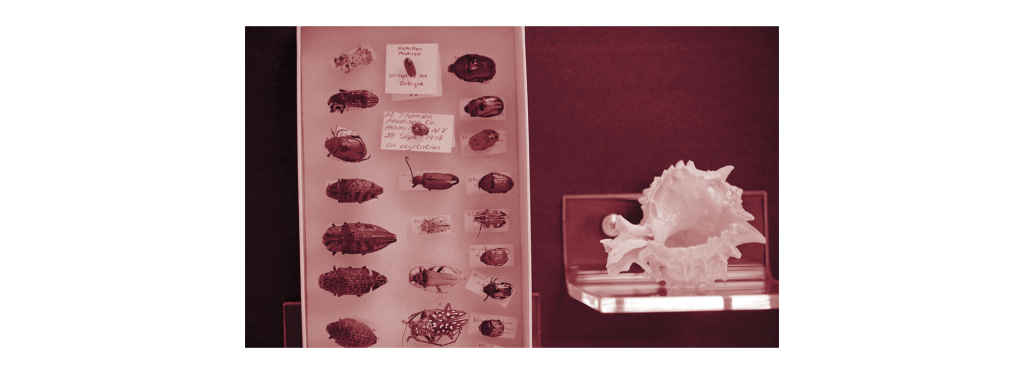
64
In 2010, former World Chess Champion Garry Kasparov addressed the Colgate community as part of the Kerschner Family Series Global Leaders. The series, which began in 2007, has welcomed such speakers as Aretha Franklin, Hillary Clinton, and Shimon Peres.
65
Peter Balakian, the Donald M. and Constance H. Rebar Professor in humanities, won the 2016 Pulitzer Prize for Poetry for his collection, Ozone Journal.
66
Over the years, Colgate has hosted a multitude of famous performers: Duke Ellington, The Doors, Fleetwood Mac, and the Grateful Dead, just to name a few.
67
Astrophysicist Neil deGrasse Tyson spoke at Memorial Chapel on “Ten Things You Should Know about the Universe” on Feb. 25, 2013.
68
Some noted politicians have made the trek to Hamilton, including former Prime Minister of Great Britain and Northern Ireland Tony Blair, former U.S. Secretary of State Colin Powell, and former President Bill Clinton.
69
Hascall Hall (also called the Old Biology Hall), built in 1884, is on the National Register of Historic Places. In 1975, students protested the demolition of the building, asking the administration to “Save Old Bio.”
70
In ’68 and ’69, students protested, demanding an “Afro-American Cultural Living Center.” In 1970, a cultural center was opened. Rededicated in 1989 and renamed in 1996, the ALANA Cultural Center is active today in educating the Colgate community on the contributions of ethnic groups.
71
In 2014, students formed the Association of Critical Collegians in concert with a 350-person sit-in protesting microaggressions against the minority community and a lack of diversity. In response, the university worked with students to create a 21-point road map to promote inclusivity.
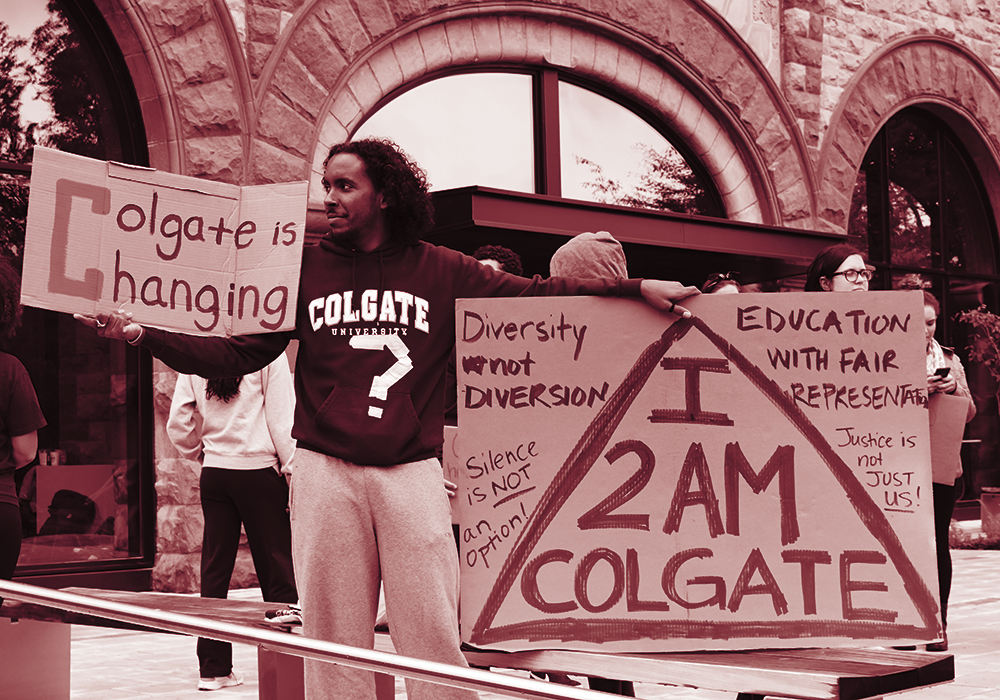
72
Christina Liu ’13 wrote This is Not a Play About Sex for her senior thesis, based on more than 30 hours of interviews with 26 students on their sexualities, genders, and bodies. The activist play debuted in 2012 and has been performed annually at Colgate ever since.
73
The ’60s were a time of cultural change at Colgate, especially concerning arts on campus. Students banded together to create two festivals: the Creative Arts Festival (1964) and Fortnight of the Active Arts (1968). The festivals featured acclaimed guests, such as Philip Roth and The Doors.
74
Anthony Aveni, Russell Colgate Distinguished University Professor of astronomy and anthropology and Native American studies emeritus, was named Professor of the Year in 1982 by the Council for Advancement and Support of Education.
75
Marietta Cheng, professor of music and director of the Colgate University Orchestra, is conductor laureate of the Orchestra of the Southern Finger Lakes.
Trivia
You have unlimited time to finish this exam
76
In 1846, Hamilton Literary and Theological Institution was renamed Madison University. What was another suggestion for the university’s new name?
a. Payne University
b. Kendrick College
c. Chenango College
77
Colgate is the ________ oldest college in the United States.
a. 66th
b. 12th
c. 82nd
78
After World War II, a College Street complex for married students was called:
A. Tomorrowland
B. Vetville
C. Soldiersville
D. Sweetheart Lane
79
How many years old is the historic Hamilton Theater?
A. 53
B. 72
C. 160
D. 123
80
Which of these was once a faculty title?
A. Professor of Bovine Husbandry
B. Professor of Physiology and Hygiene
C. Professor of Etiquette and Gentility
81
How much does the chapel bell weigh?
a. 656 pounds
b. 1,013 pounds
c. 2,005 pounds
82
How large is Taylor Lake?
A. 2 acres
B. 10 acres
C. 5.5 acres
D. 11.5 acres
83
Which of the following is not a Colgate a cappella group?
a. The Dischords
b. Mantiphondrakes
c. Whiffenpoofs
d. The Swinging ’Gates
84
Which of these was the name of a student literary publication?
a. The Caliper
b. Vortex
c. The Moon
d. Children of the Sun
e. All of the above
85
Who is the longest-serving current Colgate professor?
a. Al Strand, mathematics
b. Margaret Maurer, English
c. Tom Balonek, physics and astronomy
86
How much did Col. Austen B. Colgate pay for the university’s famed dinosaur egg?
a. $13
b. $5,000
c. $250,000
d. $1 million
(Answers at the bottom of the page)
Go, ’gate!
Storied and unstoried athletics
87
John W. Peddie, Class of 1894, organized the first football team in 1890, coached by Samuel Colgate Jr.
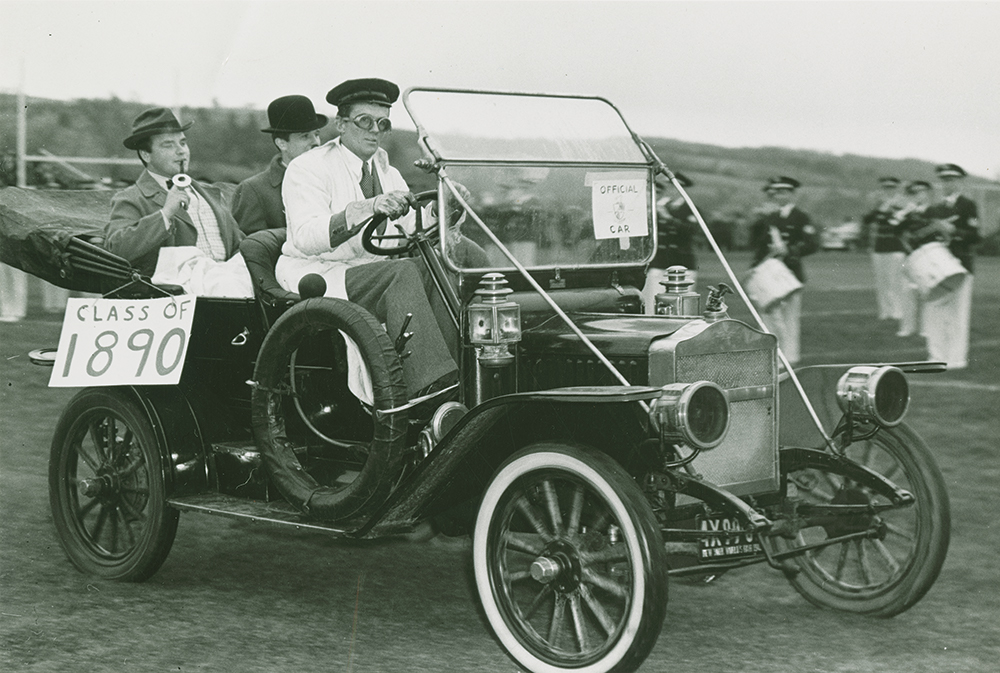
Allen Miller ’43 (driver), James Queeney (back left), and Richard LaBonte ’43
at the 50th Colgate football celebration.
88
Seating 10,221 people, the Andy Kerr Stadium was named after the head football coach from 1929–1946. Known for his impressive record and innovative strategies, Kerr was elected into the College Football Hall of Fame in 1951 and the Colgate University Hall of Honor in 1979. Today, the football and men’s lacrosse teams play in the stadium.
89
The 1932 football team was, according to Andy Kerr, “Undefeated, Untied, Unscored-Upon — and Uninvited!” The Raiders thought they were headed to the Rose Bowl to meet USC after completing a perfect 9-0 campaign and outscoring their opponents 264-0. Instead, undefeated but twice-tied Pittsburgh earned the bid.
90
The Class of 1965 Arena houses the Steven J. Riggs ’65 Rink. Riggs, a varsity hockey player while at Colgate, still holds one of the highest points-per-game averages of Colgate players. He was drafted into the Army in 1966, upgraded to a private while still in basic training, and married before being sent to Vietnam. As a respected lieutenant in command of 30 men, a newlywed, and a father-to-be, Riggs lost his life in an ambush attack. At the Class of 1965 Reunion, Riggs’s son, Steven, signed his and his father’s names into the steel beams that would form the arena.
91
NFL head coach Bill Parcells ’58, a.k.a. “The Big Tuna,” attended Colgate before transferring to the University of Wichita.
92
In 2016, Lauren Schmetterling ’10 became the first Colgate athlete to win an Olympic gold medal for her performance in the Women’s Rowing Final. Previous Olympic medalists include Frank Castleman, Class of 1906, who won the silver medal in the 200 meter hurdles (1904), and Dick McGlynn ’70, who won the silver medal with the Men’s Hockey Team (1972).
93
Captain Richard B. Morrin MA’60 scored the first hole-in-one at Colgate’s Seven Oaks golf course in 1959.
94
All of Colgate’s varsity teams are Division I.
95
Intercollegiate athletics began at Colgate with baseball. Its first game was played in 1867 — just two years after the Civil War. The football team played its first game in 1890, followed by basketball in 1900, track and field in 1901, hockey and tennis in 1915, soccer in 1920, lacrosse in 1921, golf in 1923, and swimming and diving in 1927.
96
1955: the baseball team earned a trip to the NCAA College World Series.
97
The first women’s teams — basketball, field hockey, lacrosse, swimming and diving, tennis, and volleyball — launched in 1973–74.
98
Dr. Merrill Miller was the first female head physician for a Division I college football team.
99
Starr Rink, former home of Colgate hockey, appears in the 1977 sports movie classic Slap Shot starring Paul Newman.
100
Ernie Vandeweghe ’49 was the university’s first All-America basketball player. After graduation, Vandeweghe played six seasons between 1949 and 1956 with the New York Knicks. He played 224 regular-season games for the Knicks while attending Columbia University Medical School. He later married Colleen Kay Hutchins (Miss America 1952) and passed his athleticism on to their children.
101
Colgate hosted the 1977 NCAA Men’s Golf Championship at Seven Oaks. Scott Simpson won medalist honors. His winning total of one over par stands as one of just four times since 1965 that the individual champion finished with a score above par.
102
The type of sand in the bunkers at Seven Oaks Golf Club is the same as that in the traps at Augusta National.
103
Men’s hockey won its first ECAC Hockey tournament title in 1990 and advanced to the NCAA championship game.
104
The Raiders are the only Patriot League team to play for a football national championship. They’re also the only Patriot League program to win two games or more in a single NCAA playoff. Colgate won three games in 2003 and two games in 2015.
105
Women’s hockey set a program record in 2018 with 34 victories and advanced to the program’s first Women’s Frozen Four and national championship game. Colgate’s 20 home wins were the most in Division I women’s or men’s hockey.
106
Former football head coach Dick Biddle encouraged students to eat cake. One Wednesday, after serving his team a cake that said “don’t be cake eaters,” meaning “don’t be soft,” the team won their Saturday game. Being superstitious, the team started eating cake every Wednesday in the locker room.
Through the Years
Exactly how times have changed
107
$100 in 1819 is worth $1,905.59 today.
108
No.1 songs on the Billboard Top 10 list through the decades:
- 1960s: “The Twist” by Chubby Checker
- 1970s: “You Light Up My Life” by Debby Boone
- 1980s: “Physical” by Olivia Newton-John
- 1990s: “How Do I Live” by LeAnn Rimes
- 2000s: “We Belong Together” by Mariah Carey
109
Slang through the centuries:
- 1819: Nanty narking (great fun), hum (home)
- 1919: Hoosegow (prison), duck soup (something easy), skidoo (leave), hawkshaw (detective), goop (moron)
- 2018–19: Woke (culturally and politically aware), GOAT (greatest of all time), snack (an attractive person)
110
On screen:
- 1919: Mickey, Tarzan of the Apes
- 1969: Butch Cassidy and the Sundance Kid, Midnight Cowboy
- 2019: The Lego Movie 2, Captain Marvel (both scheduled for release)
111
Tuition costs:
1869 $20
1892 $45
1908 $60
1922 $180
1962 $1375
1968 $2285
112
Some suggestions for “How to Dress Well, Though in College” from a 1922 Madisonensis:
- One pair of black flannel trousers
- One maroon sweater (Go, ’Gate!)
- A sheepskin
- Indestructible and unwashable socks
- Shoes
- Hats (only recommended for first-years)
113
This is how the United States looked at Colgate’s last big celebration, its Centennial:
- President: Woodrow Wilson
- Women’s rights: Congress approves the 19th Amendment.
- Atta’ boy: Babe Ruth joins the Yankees.
- Dry country: The United States enters the first stages of Prohibition.
- Grand Old Flag: 13 stripes, 48 stars
Serving Our Country
Campus has not been immune to the effects of wartime
114
More than 110 Madison University alumni served in the Civil War.
115
During the Civil War, students celebrated victories by firing a cannon in front of East and West Halls.
116
During World War I, campus served as a military post so that students could prepare for combat. The Colgate University Students Army Training Corps was organized on Oct. 1, 1918, and continued until Dec. 18, 1918.
117
600: The approximate number of men — about three-fourths of the student body — who left by May 1917 to join the armed services or assist in the war effort during World War I. When the fall semester began, the students who remained were required to practice military drills.
118
Two German doctors visited Colgate in 1933 to take notes on the university’s successful athletics program. Members of the Berlin Olympic Committee and the Nazi Party, they assured students that war was improbable and that Jews were not being persecuted.
119
Colgate was one of 131 colleges to offer a V-12 Navy College Training Program as a pathway for students to obtain Navy commision during World War II. It was also one of 20 flight preparatory schools in the nation, training future military pilots.
120
Though many faculty members served during World War II through teaching on campus, others helped overseas in places like the U.N. Relief and Rehabilitation Administration and the Supreme Headquarters Allied Expeditionary Force.
121
In the midst of the United States’ involvement in World War II, a Colgate airport was opened with the tagline “Home of the Flying Red Raiders.”
Women at Colgate
They made a difference long before coeducation
122
President Stephen Taylor’s daughter, Emily, is perhaps the first woman to study at the university in the 1850s. She sat in on classes, studied German, and gave her work to Professor Ebenezer Dodge for proofing.
123
Mabel Dart, Class of 1882, had to pass an exhaustive series of entrance tests before she was allowed to take classes at Colgate. She was one of the first women to be admitted. The Dart Colgrove Commons is named for her.
124
Josephine Young Case, President Everett Case’s wife, was an accomplished poet and novelist. In 1969, she wrote a novel about living in Hamilton and taught a literature course at Colgate.
125
Helen Craven Mues was the first GI wife to register at Colgate.
126
September 1970: Colgate became officially coed.
127
When Colgate became coed, the alma mater’s second stanza was changed to “Yearly rove thy loving ones” instead of “sons.”
128
The Swinging ’Gates, Colgate’s first female a cappella group, released the album Stop Staring, Start Listening in 2017.
129
First tenured female professor: Carol Bleser in 1970
130
1974 was called the “Year of Woman” because of the number of female faculty members granted tenure. Recipients included Marilyn Thie (philosophy, religion, and women’s studies), Margaret Maurer (William Henry Crawshaw Professor of literature), Myra Smith (psychology), Lynn Staley (Harrington and Shirley Drake Professor of the humanities and medieval and Renaissance studies), and Mary Bufwack (women’s studies).
131
One of the first full-time female professors hired, Jane Pinchin became the first female Dean of Faculty in 1994. In 2001, she became interim president. She is currently the Thomas A. Bartlett Chair and Professor of English emerita.
132
Colgate’s first residential living community, Ciccone Commons, was named after Diane Ciccone ’74, one of the first female graduates who is now a trustee emerita.
133
Another trustee emerita, CNN political analyst Gloria Borger ’74 was the first female editor of the Maroon.
134
Former President Rebecca Chopp (2002–09), Colgate’s only female president, calls Emily Dickinson a role model “because of her love of words and simplicity and her ability to think outside of the box about the ordinary as well as the extraordinary.”
People
The brilliant, the eccentric, and the just plain memorable
135
First president: Nathaniel Kendrick (1836–1848)
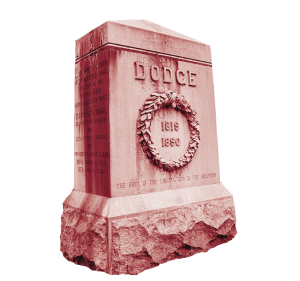
136
Many Colgate luminaries are buried in the university cemetery, such as President Ebenezer Dodge, founders Samuel Payne and Jonathan Olmstead, and English professor Jonathan Kistler.
137
Jonathan Wade, who hailed from Hartford, N.Y., was the first student. Arriving approximately a year before the institution formally opened, he learned Latin in the home of Daniel Hascall, one of the university’s founders.
138
Colgate’s second student, Eugenio Kincaid, walked 160 miles to Hamilton from DeKalb, N.Y., to study with Daniel Hascall. On his way to the village, he chopped wood to pay for his meals and lodging.
139
More than 1,300 alumni returned to campus for the Centennial celebration Oct. 9–12, 1918.
140
Today’s student body includes 285 undergraduates from 50 countries. Their paths were paved by Moung Kyaw, Class of 1868. Kyaw, the university’s first international student, came to Hamilton from Burma (now Myanmar). According to letters in the university archives, Colgate’s first student from “India,” which may have been Kyaw, brought a Buddha. When he converted to Christianity, he broke off the Buddha’s head and returned to Burma to become a missionary.
141
Charles Evans Hughes, former chief justice of the Supreme Court, enrolled at Colgate when he was just 14 years old. The swing voter was a member of Delta Upsilon, and he transferred to Brown University, where he finished his undergraduate degree.
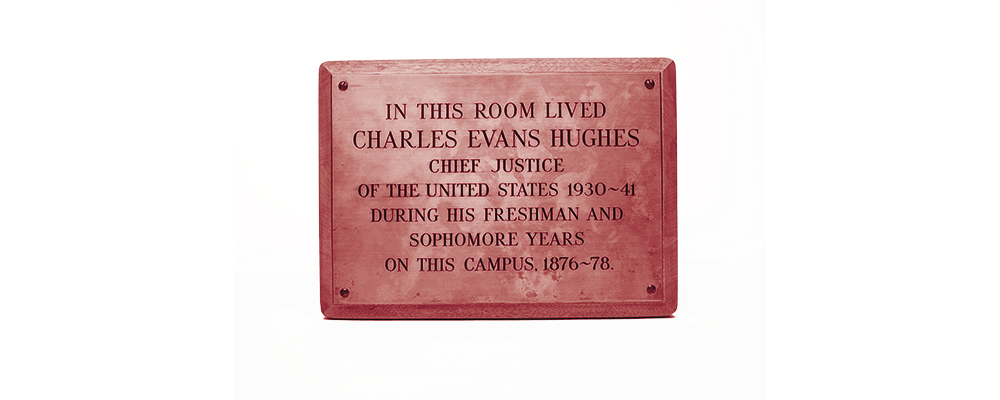
142
When George Edmands Merrill became Colgate’s sixth president in 1899, he was given a house and an annual salary of $4,000 (about $116,000 today).
143
Oswald Avery, Class of 1900, performed an experiment with his co-workers revealing that DNA holds genetic information.
144
In the 1903 edition of Who’s Who In America, 24 Colgate men were listed, including George E. Merrill and James B. Colgate.
145
Lyle Bishop Chapman, Class of 1913, was one of the “Untouchables” — a group of feds tasked with taking down the infamous Al Capone and his booze ring.
146
Although he was Jewish, Johnny Marks, Class of 1931, wrote holiday favorites including “Rudolph the Red-Nosed Reindeer,” “Rockin’ Around the Christmas Tree,” and “A Holly Jolly Christmas,” among others.
147
Charles Addams, Class of 1933, was the creator of the Addams Family, which started as cartoons in the New Yorker. The house at 52 Maple Avenue in Hamilton is said to be the basis for the Addams Family house.
148
Harry Emerson Fosdick, Class of 1900, was a prominent figure in the Fundamentalist-Modernist Controversy within the Presbyterian Church. He was also a founding pastor of New York City’s Riverside Church.
149
Yoichi Okamoto ’38 was the second official White House photographer. Known as “Oke,” he candidly captured photos of Lyndon B. Johnson.
150
Newsman Andy Rooney ’42 admired the work of E.B. White. “I read everything E.B. White ever wrote,” Rooney said in 2010. “He wrote very simply and directly. And whatever the subject was, it was always good.”
151
Adonal Foyle ’98, who played in the NBA for 13 years, came to Hamilton when he was 15 years old from St. Vincent and the Grenadines.
152
Colgate has a long history of sending alumni to the Peace Corps. Since 1961, more than 300 alumni have served in more than 77 different countries.
153
President Brian Casey holds a PhD from Harvard in the history of American civilization, focusing on the history of higher education and American intellectual history.
Mystery and Miscellany
From coincidental to spooky
154
A.D. Gillette, who attended the Hamilton Institution from 1828–31, was the minister who prayed with President Lincoln’s assassins before they went to the gallows.
155
One of the most important backers of the early days of the institution was William Colgate, a prominent soap and candle maker who lived in New York City. A devout Baptist, he was interested in fostering ministerial education.
156
When his steamship hit an iceberg and almost sank in 1879, James B. Colgate donated $50,000 (more than $1 million today) “to recognize God’s providence.”
157
The first volume of the Salmagundi, meaning “miscellany” or “medley,” was published in 1883. Its editor was James C. Colgate. While its content originally focused on lists of faculty, fraternities, and other organizations on campus, it became the yearbook in 1934.
158
On March 15, 1890, the New York Times reported the university’s name change to Colgate. “The change is hailed by the students with great joy, and a new yell was ringing out in the village soon after the receipt of the telegrams. It is: ‘Yell high, yell great; ’rah ’rah, Colgate!’ The faculty immediately declared a holiday, and it was spent in jubilating over the victory.”
159
In its archives, Colgate has several canes, which were en vogue accessories in the late 19th century.
160
Hotel Hamilton was decorated for the visit of Charles Evans Hughes, Class of 1880, then governor of New York, June 22, 1909 (pictured below).
161
Ski races were a part of the university’s annual winter carnival tradition. In the early 1900s, those in fraternities and student residences hit the snow to compete for the house cup.
162
In 1918–19, 80 students contracted the Spanish Flu. Only one Colgate student died from the pandemic that killed millions.
163
Some areas of campus are rumored to be haunted, including Andrews Hall, Eaton Hall, and Merrill House. In 2016, Ghost Hunter John Zaffis investigated and found evidence that paranormal activity may exist in Merrill House.
164
While we rep maroon today, Colgate’s original colors were blue and magenta (1868–1886) and then orange and maroon (1886–1900).
165
You may have been to a tunk, but have you ever wondered what the Colgate-specific word means? The origin refers to a masculine social situation; both students and faculty have used the term through the years.
166
Mystery of the missing plaster casts: Colgate used its collection of plaster casts as teaching tools. Most of the casts were donated in honor of Trustee George L. Stedman in the early 1900s, and they were housed in the reading room at the James B. Colgate Library. Sometime between 1943 and 1956, they were removed and are rumored to have been taken to the local dump. Only the busts of Homer and Virgil remain on campus.
167
How many of these Hamilton establishments do you remember? John’s Shoe Shop, PM Jones, Rausa’s Smoke Shop, Blue Bird Restaurant, Reed’s Hardware, Crowe’s Drug Store, Roger’s Market, Trask Motors, Vantine Studios, McLaughlin’s, The Nautilus, Rosita’s, Numero Uno, The Trillium, Cat’s Meow, Bubba’s Burritos, and Loose Caboose.
168
Colgate’s seal depicts a hand holding a torch, along with a scroll bearing the Latin motto Deo Ac Veritati (For God and Truth).
169
Colgate’s mace — the object carried by the university marshal leading the commencement procession — dates back to 1991. Its creation was spearheaded by biology professor William J. Oostenink. The acorn and oak leaves at the top represent strength, stability, and continuity.
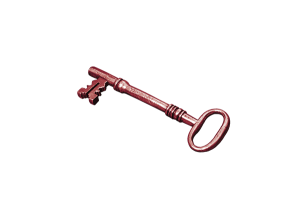
170
Pictured: the university key, kept in the archives. “A key may be used to lock oneself in or open the door to a wider life. Colgate has always stood for the open door.” — John Golden ’66, former chair of the Board of Trustees
171
President Brian Casey’s dog, Emrys, has his own Instagram account: @Emrys_at_Colgate
172
Nestled in the Adirondacks, Colgate Camp is a summer tradition for many in the university community. The descendants of Colgate’s 10th president, Vincent Barnett Jr. (1963–69), are the first on the camp’s calendar each season.
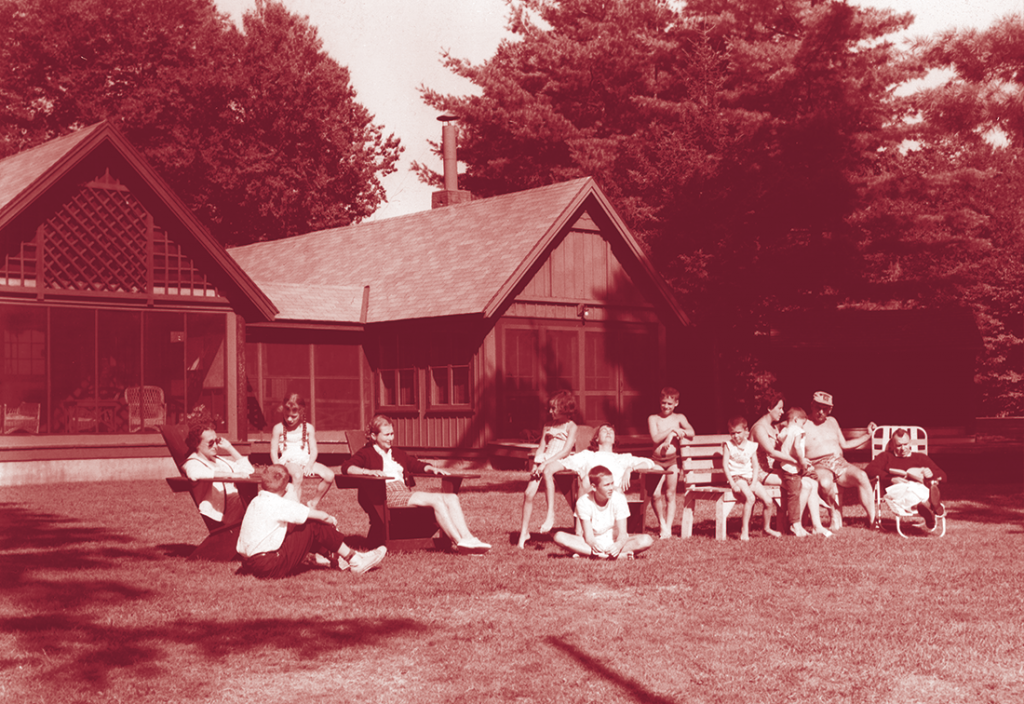
173
When Michael Torpey ’02 landed the part of Norm in the movie Pottersville, he had no idea it’d be filmed in Hamilton. “I was floored,” he said.
174
By simply saying “hi” to everyone you meet on campus, you’re participating in a nearly century-old Colgate tradition. The first published mention of the “Colgate Hello” was in the 1924–25 student handbook.
175
Hamilton’s zip code, aka “the hip zip,” is 13346. The first two numbers are 13 and the last three numbers add up to 13.
The Campus
This must be the place
176
42°49’10″N 75°32’11″W: Colgate’s coordinates.
177
In 1794, Samuel Payne, one of Hamilton’s first settlers, “felled the first tree in a virgin wilderness.” He prayed and dedicated to God the land that is now Colgate’s campus.
178
“The Hill” was previously known as “Payne Hill.”
179
The boarding hall served up less carb-conscious meals of oatmeal, pancakes, and bread in the early 1800s.
180
Rooms were lit by whale oil lamps or candles in the early years.
181
The campus’s oldest buildings are constructed from Chenango sandstone.
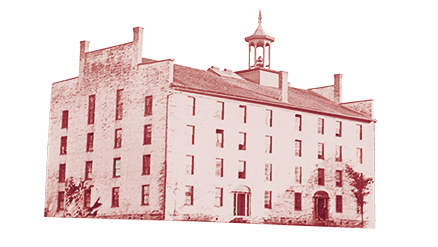
182
Built by students and faculty in 1827, West Hall is the oldest structure on campus. It was originally called Western Edifice. The building’s gray limestone came from the quarry above the old golf course.
183
Nicholas Brown, patron of Brown University, donated $1,000 toward the building of West Hall.
184
Removal crisis: In 1847, faculty members and alumni considered moving the university to Rochester or another city with more opportunities than Hamilton.
185
James B. Colgate Hall initially was called James B. Colgate Library when it was erected in 1891. It now houses the Office of Admission.
186
James B. Colgate Library cost $140,000 to build.
187
The Academic Quad took shape in 1918.
188
Stairway to heaven: Architect Paul Rudolph’s original plans for the Dana Arts Center included a stairway linking the roof sculpture court with the upper campus.
189
“Angel Factory”: Because of the university’s theological ties, this was the nickname for Eaton Hall when it was turned into residence halls in 1928 after the seminary relocated to Rochester.
190
A conveyor track system brought books from James B. Colgate Library to Everett N. Case Library in 1958.
191
In 1959, Chapel House was built with a gift from a donor who asked that her identity never be revealed.
192
13: The number of steps between each floor in Alumni Hall.
193
The Class of 2002 gave the wall and garden in front of Merrill House in remembrance of 9/11.
194
Fossils decorate the side of Hascall Hall.
195
You can walk from Lathrop Hall to the Ho Science Center without ever stepping outside —just go through the tunnels.
196
The W.M. Keck Center for Language Study, located in Lawrence Hall, allows students to immerse themselves in language and culture in a high-tech environment.
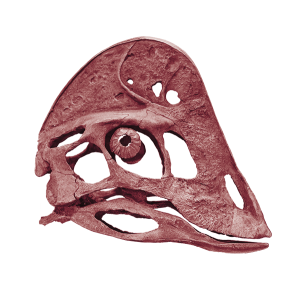
197
The Robert M. Linsley Geology Museum houses a 7-foot-long mammoth tusk, a mural depicting Hamilton 375 million years ago, and fossil samples.
198
The Colgate Community Garden is home to eggplant, watermelon, kohlrabi, and … honeybees. In 2017, students brought two hives to the location.
199
25: Years the Saperstein Center has been active. Read more in this issue on the Saperstein Center in Our Story.
200
Current photo of Olmstead House, where the 13 founders first gathered.
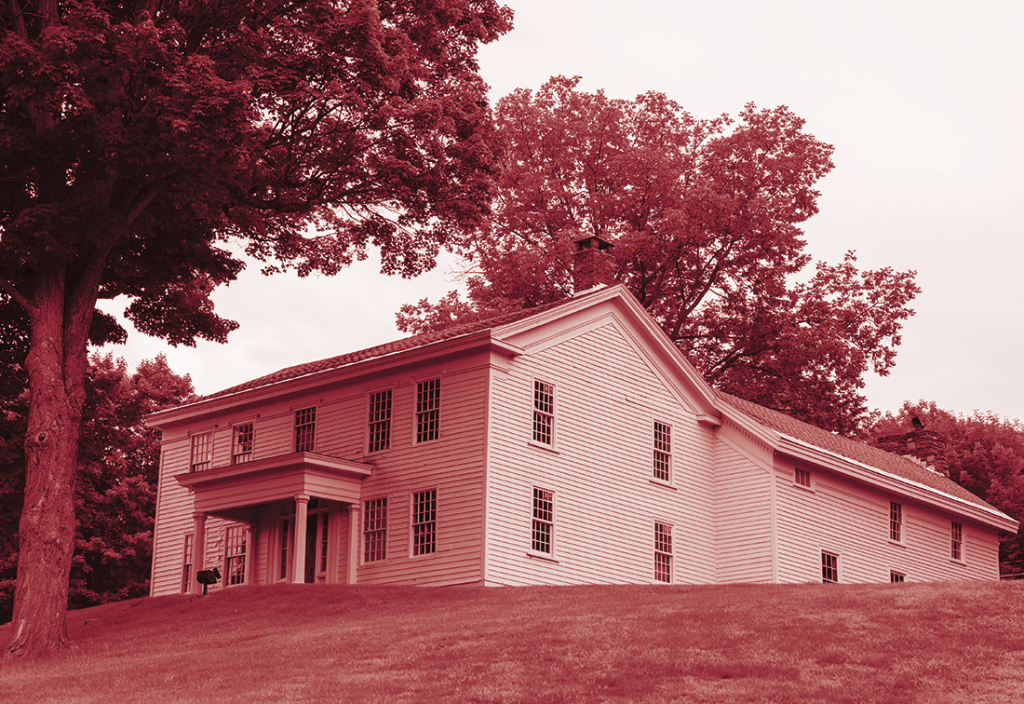
Current photos by Mark DiOrio; archival photos from Special Collections and University Archives
Trivia Answer Key
76. c. Chenango College / 77. a. 66th / 78. b. Vetville / 79. d. 123 / 80. b. Professor of Physiology and Hygiene / 81. c. 2,005 pounds / 82. c. 5.5 acres / 83. c. Whiffenpoofs / 84. e. All of the above / 85. a. Al Strand, mathematics, who started in 1969 / 86. b. $5,000

